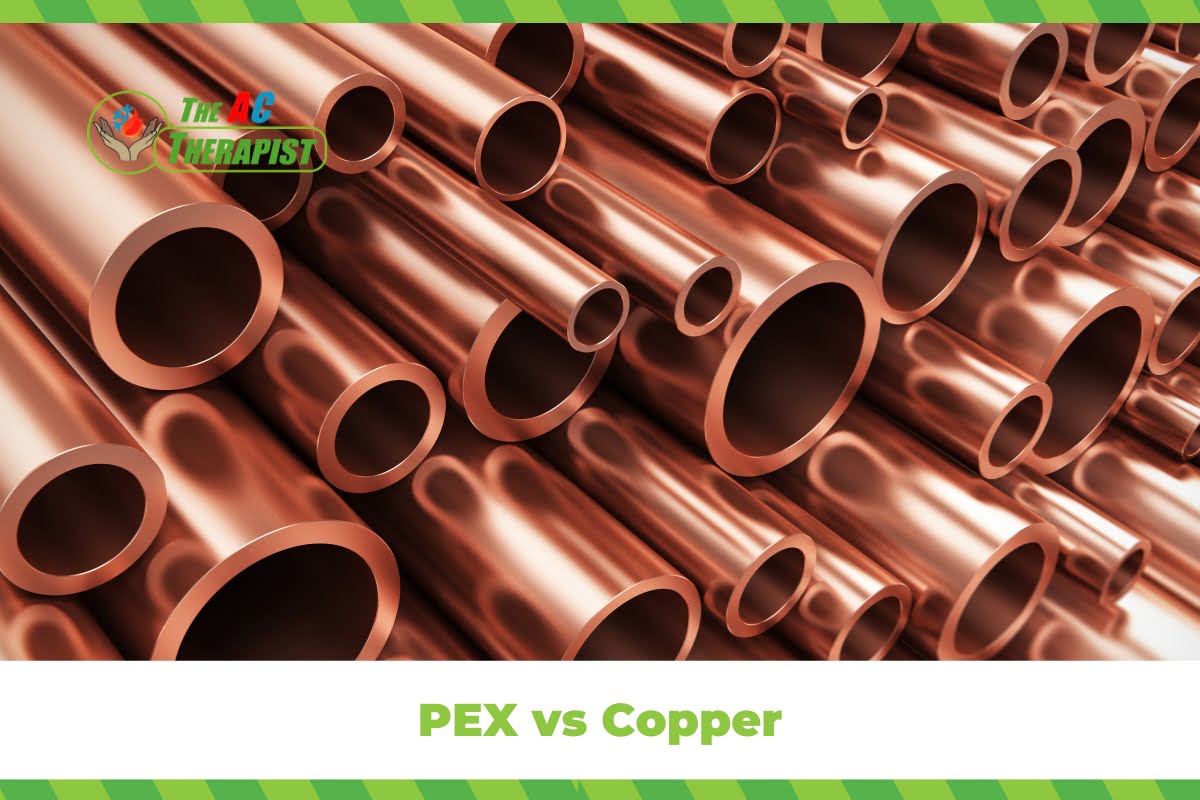PEX vs Copper
Choosing the right piping material for residential or light commercial plumbing projects is crucial for the building’s water system’s longevity, efficiency, and safety. With a variety of materials available on the market, property owners and contractors often find themselves weighing the benefits and drawbacks of each option to determine the best fit for their specific needs. Among the most commonly considered materials are PEX (Cross-Linked Polyethylene) and copper pipes, each with its unique set of characteristics, applications, and considerations.
PEX pipes, known for their flexibility and cost-effectiveness, have gained significant popularity in recent years, especially for new constructions and renovations. On the other hand, copper pipes, with their long history in plumbing, are prized for their durability and reliability. The choice between PEX and copper can significantly impact the project’s overall cost, the complexity of installation, and the system’s performance over time.
This blog post aims to provide a comprehensive comparison between PEX and copper pipes, exploring their pros and cons, applications, and factors to consider when making your selection. Whether you’re a homeowner looking to upgrade your plumbing system or a contractor advising clients on the best materials to use, understanding the differences between PEX and copper is essential. Let’s dive into the details to help you make an informed decision that ensures the longevity and efficiency of your plumbing system.
What is PEX?
Cross-linked polyethylene, commonly known as PEX, is a type of plastic that has been chemically altered to improve its strength and temperature resistance. This modification process, known as cross-linking, bonds the polymer chains together, enhancing the material’s durability and allowing it to withstand a wide range of temperatures—from cold to hot water applications. PEX pipes are increasingly popular in residential and light commercial plumbing projects due to their flexibility, resilience, and cost-effectiveness.
PEX comes in various types, primarily categorized as PEX-A, PEX-B, and PEX-C, based on the method used for cross-linking. PEX-A is known for its higher flexibility and memory properties, allowing it to return to its original shape after expansion. PEX-B offers excellent resistance to chemical and environmental stress cracking, while PEX-C, though less commonly used, provides a good balance of strength and flexibility.
Advantages of PEX Pipes
Cost-effectiveness
One of the most significant advantages of PEX piping is its cost-effectiveness. Not only are the materials generally cheaper than copper, but the installation costs are also lower due to the ease and speed with which PEX can be installed. The flexibility of PEX means it requires fewer fittings and less labor, reducing the overall project cost.
Flexibility
PEX’s flexibility is a major benefit, particularly in applications where pipes need to be routed through tight spaces or around obstacles. This flexibility minimizes the need for fittings and joints, which can be potential points of failure in a plumbing system. Moreover, PEX can expand slightly to accommodate the expansion of frozen water, reducing the risk of burst pipes in freezing conditions.
Ease of Installation
Installing PEX piping is relatively simple and quick, especially compared to copper. It requires fewer tools and can be done by a single installer, cutting down on labor costs and time. The ease of installation also makes it an attractive option for DIY projects, although professional installation is recommended to ensure the system meets all local codes and regulations.
Corrosion and Scale Resistance
PEX pipes are resistant to corrosion and scale buildup, which can plague metal pipes such as copper. This resistance helps maintain water quality and flow rate over time. Additionally, PEX does not leach substances into the water, making it a safe choice for drinking water supply lines.
Comparing PEX and Copper
When deciding between PEX and copper pipes for plumbing projects, it’s important to compare them across several key dimensions to determine which best suits your needs. Here’s a detailed look at cost, performance, maintenance, and other factors.
Cost Comparison
PEX Pipes: PEX stands out for its cost-effectiveness. The materials themselves are less expensive than copper, and the installation costs are also lower. PEX’s flexibility allows for longer continuous runs and fewer connections, reducing the need for fittings and the overall labor time and cost. Additionally, the lightweight nature of PEX makes it cheaper to transport.
Copper Pipes: Copper is generally more expensive both in terms of material and installation costs. The price of copper can fluctuate significantly based on the global commodities market, potentially impacting project costs. Installing copper pipes requires more labor and skill, particularly because of the need to solder joints, which adds to the overall expense.
Performance and Maintenance
PEX Pipes:
- Performance: PEX is highly resistant to corrosion and scale buildup, ensuring a consistent flow rate and water quality over time. It also has good thermal insulation properties, reducing heat loss in hot water lines.
- Maintenance: PEX requires minimal maintenance, thanks to its resistance to corrosion and its ability to expand and contract without bursting. This resilience to freezing temperatures is a significant advantage in colder climates.
Copper Pipes:
- Performance: Copper pipes offer excellent durability and can last over 50 years if properly installed and maintained. They are also resistant to UV light, making them suitable for outdoor use where PEX cannot be used.
- Maintenance: While copper is resistant to corrosion in most environments, it can be susceptible to pitting and corrosion in areas with acidic water. This can eventually lead to leaks and require repairs or replacement. Regular inspections are recommended to identify any potential issues early.
Environmental Considerations
PEX Pipes: PEX is less environmentally friendly in terms of its production, as it is a plastic product derived from petroleum. However, its durability and energy efficiency in use (due to its thermal insulation properties) contribute positively to its overall environmental impact.
Copper Pipes: Copper is a natural material that’s 100% recyclable without losing any of its quality. This makes copper pipes a more sustainable option over their lifespan. The extraction and manufacturing processes, however, are energy-intensive and contribute to their environmental footprint.
Health and Safety
PEX Pipes: Concerns have been raised about the potential for PEX pipes to leach chemicals into the water supply, particularly when exposed to high temperatures. However, modern PEX pipes are manufactured to meet strict health and safety standards, ensuring that any risk is minimal.
Copper Pipes: Copper is known to have antimicrobial properties, and the material does not leach harmful substances into the water. However, the solder used in copper plumbing can contain lead, although the use of lead-free solder is now widespread and regulated.
Application and Use Cases
When evaluating the application and use cases for PEX vs Copper, it’s essential to consider the unique advantages and constraints each material offers. The choice between PEX and Copper impacts not only the initial installation but also the long-term performance and maintenance of the plumbing system. Let’s explore where and when to use PEX vs. Copper, emphasizing the keyword to highlight their distinct applications.
When to Use PEX
PEX in Residential Applications: For residential plumbing, PEX vs Copper often leans in favor of PEX due to its flexibility, ease of installation, and cost-effectiveness. PEX is particularly well-suited for retrofitting in existing homes, where running new pipes can be challenging. The ability of PEX to weave through walls and floors with minimal disruption gives it an advantage over Copper in renovation projects.
PEX in Radiant Floor Heating: When comparing PEX vs Copper for radiant floor heating systems, PEX is the clear winner. Its flexibility allows for easy installation in tight spaces, and its resistance to high temperatures makes it ideal for hot water circulation.
PEX in Areas with Aggressive Water: In the battle of PEX vs Copper, PEX pipes are better suited for areas with highly acidic or aggressive water conditions. Unlike Copper, PEX does not corrode, ensuring that the water quality remains unaffected and the lifespan of the plumbing system is extended.
When to Use Copper
Copper in Outdoor Applications: Discussing PEX vs Copper, it’s important to note that Copper is more suitable for outdoor plumbing applications. Copper’s resistance to UV light ensures that the pipes will not degrade when exposed to sunlight, a limitation often cited in the PEX vs Copper debate for outdoor use.
Copper in Commercial Projects: In the context of PEX vs Copper for commercial plumbing, Copper often comes out ahead due to its durability and the higher pressure ratings it can withstand. For large-scale installations where longevity and robustness are critical, Copper is frequently the preferred choice.
Copper for Aesthetic Appeal: When aesthetics are a consideration in the PEX vs Copper decision, Copper pipes can offer a visual advantage, especially in exposed plumbing designs where the metallic look of Copper is desired over the plastic appearance of PEX.
Limitations and Considerations
PEX vs. Copper in Environmental Conditions: While discussing PEX vs Copper, it’s crucial to consider the environmental conditions of the installation site. PEX should not be used where it will be exposed to direct sunlight for prolonged periods, as UV rays can degrade the material. Conversely, Copper’s susceptibility to corrosion in certain water types may limit its use in areas with aggressive water conditions.
PEX vs. Copper in Code Compliance: The choice between PEX vs Copper may also be influenced by local building codes and regulations. Some areas may have specific requirements or restrictions for the use of PEX or Copper, making it essential to consult local codes when deciding between PEX and Copper.
PEX vs. Copper in Health Concerns: Health considerations play a role in the PEX vs Copper discussion. While modern PEX materials meet strict safety standards, some homeowners prefer Copper due to its natural antimicrobial properties and proven track record.
Making the Right Choice
Making the right choice between PEX and Copper for your plumbing needs involves understanding the distinct benefits and potential drawbacks each material brings to the table. The debate over PEX vs Copper is not about which is universally better but which is more suited to your specific project requirements, preferences, and local regulations. Let’s break down the key factors to consider when choosing between PEX and Copper, emphasizing the keyword to guide your decision-making process.
Consider Your Project’s Specific Needs
When deciding between PEX and Copper, assess the specific needs of your project. PEX offers significant advantages in terms of flexibility, ease of installation, and resistance to freezing temperatures, making it an excellent choice for indoor plumbing, especially in tight spaces or where the water in the area is aggressive towards Copper. On the other hand, Copper’s durability, resistance to UV light, and aesthetic appeal may make it the preferred choice for outdoor applications, exposed plumbing, or where a more traditional look is desired.
Evaluate Cost Implications
The cost difference between PEX and Copper can be substantial, with PEX often being the more budget-friendly option when considering both materials and labor. If cost is a primary concern in your project, evaluating the PEX vs. Copper options might lean your decision towards PEX. However, it’s also important to consider the long-term value Copper may provide, given its longevity and potential impact on property value.
Understand Local Building Codes
Local building codes can significantly influence the PEX vs Copper decision. Some regions may have specific restrictions or preferences for using PEX vs Copper in plumbing installations. Ensuring compliance with local regulations is essential when choosing between PEX and Copper, as this can affect not only the legality of your project but also its safety and insurance implications.
Consider Environmental and Health Factors
In the PEX vs. Copper debate, environmental and health considerations are increasingly important. For those concerned about the environmental impact of their choices, the PEX vs Copper decision might tilt towards Copper due to its recyclability and lower environmental footprint during production. However, modern PEX materials are designed to be safe and have minimal health risks, complying with stringent standards for water safety.
Seek Professional Advice
Given the complexities involved in choosing between PEX and Copper, seeking professional advice is crucial. A qualified plumber or contractor can provide insights into the PEX vs Copper debate, tailored to your project’s specific context. They can help navigate the advantages and limitations of PEX vs Copper, considering factors such as local climate, water quality, and building structure.
The decision between PEX vs. Copper requires careful consideration of various factors, including project needs, cost, local codes, environmental and health concerns, and professional advice. There is no one-size-fits-all answer in the PEX vs. Copper debate; the best choice depends on the unique aspects of each project. By thoroughly evaluating each option’s pros and cons in the context of your specific situation, you can make an informed choice between PEX vs. Copper which ensures the longevity, efficiency, and safety of your plumbing system.
Mastering the Flow: Navigating the PEX vs Copper Pipes Debate with The AC Therapist & Plumbing Therapist
Diving deep into the PEX vs Copper debate reveals a world where each material’s nuances significantly impact your plumbing system’s overall performance, longevity, and efficiency. At The AC Therapist, alongside our sister company, Plumbing Therapist, we’re not just observers in the PEX vs Copper discussion; we’re seasoned experts committed to guiding you through these waters with precision and care. Understanding the ins and outs of PEX vs Copper is more than a technical exercise—it’s about making informed choices that resonate with your specific plumbing and HVAC needs, ensuring your home or business operates seamlessly.
In the realm of PEX vs Copper, several factors come into play, including cost, installation ease, durability, environmental impact, and suitability for different environments. Our journey through the PEX vs. Copper landscape has illuminated the strengths and considerations of each option, providing you with the knowledge needed to make an informed decision. As proponents of both PEX and Copper, The AC Therapist and Plumbing Therapist believe in a balanced approach, recognizing that the choice between PEX and Copper often depends on the unique demands of each project.
Our dedication to excellence in HVAC and plumbing services means we’re here to support you at every step of the PEX vs Copper decision-making process. Whether it’s the cost-effectiveness and flexibility of PEX that aligns with your project goals or the time-tested reliability and aesthetic appeal of Copper that catches your eye, our team is equipped to deliver solutions that not only meet but exceed your expectations.
Navigating the PEX vs Copper debate with our clients involves a tailored consultation to assess all angles—budgetary constraints, project timelines, environmental conditions, and aesthetic preferences. The AC Therapist and Plumbing Therapist stand ready to translate these discussions into actionable plans, ensuring your choice between PEX vs. Copper reflects the best possible outcome for your plumbing system.
In conclusion, the PEX vs Copper debate isn’t just about choosing a pipe material; it’s about choosing a partner who understands your needs and can provide the expertise necessary to make those choices a reality. With The AC Therapist and Plumbing Therapist, rest assured that your plumbing and HVAC systems are in skilled hands, ready to tackle the challenges and opportunities presented by both PEX and Copper. Trust us to make your PEX vs Copper decisions stress-free, ensuring your systems are not only efficient and reliable but also tailored to the unique needs of your home or business.












